San Luis Potosí city, San Luis Potosí 作者: 来源: 发布时间:2021-07-22
1.Basic data
Population: 824,229 (2015)
Metropolitan area: 1,133,571 Área: 1443.14 km2
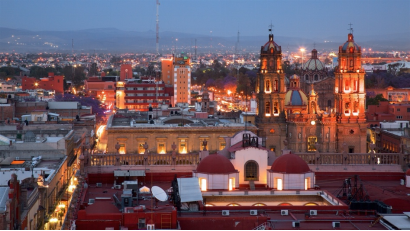
2. Natural geography
At 2,000m (6,000 feet) above sea level, it’s one of Mexico’s highest cities, and lies at the heart of the interior plateau in Mexico known as Bajío.
Weather
San Luis Potosí features a cold semi-arid climate (BSk) under the Köppen climate classification. Its high altitude means that the city experiences only a handful of hot days each year. While the climate exhibits noticeably cooler (January and February) and warmer periods (April and May) of the year, temperatures are relatively consistent throughout the course of the year. San Luis Potosí receives, on average, 392.1 mm (15.44 in) of precipitation annually, mostly seen from May through October. Snowfall is a rare occurrence. The last recorded snowfalls occurred on January 1967, December 13, 1997, December 2011, March 2016, and December 8, 2017.
Getting there and around
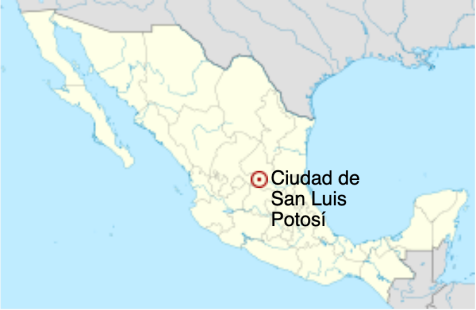
The city has public transport systems based on urban buses and taxis that travel throughout the metropolitan area. In addition, work is currently underway on the implementation of an articulated bus system known as the metrobús, of which the road conditioning works have already begun where there will be a lane exclusively confined for the metrobús projected to start operations in 2018. In addition to this, The idea of building a tram to relieve the city's traffic, mainly towards the industrial zone, has been being negotiated as reported by the city government.
By Air – You can fly to San Luis Potosi from the US and and other points in Mexico including Mexico City, Guadalajara and Leon. The airport is just 17 miles from the city center.
Taxis charge around M$200 to M$250 for the half-hour trip to/from the airport. Coming into the city there's a fixed rate of M$260.
To reach the center from the bus station, take any 'Centro' or bus 46. A convenient place to get off is on the Alameda, outside the former train station. A booth in the bus station sells taxi tickets (M$35 to M$70) to the center.
From the center to the bus station, take any 'Central TTP' or bus southbound on Avenida Constitución from the Alameda's west side.
City buses run from 6:30am to 10:30pm (M$8). For places along Avenida Carranza, catch a 'Morales' (bus 9) or 'Carranza' (bus 23) at the bus depot behind Museo de Ferrocaril.
Source: https://www.lonelyplanet.com/mexico/northern-central-highlands/san-luis-potosi/narratives/practical-information/transport/getting-around
3. Economy
A calculation of the GDP in San Luis Potosí in 2010 using a parametric methodology estimated it in 70172.9 millions of pesos.
Source: https://dialnet.unirioja.es/descarga/articulo/4954700.pdf
4. Industry
The city concentrates its economy on the industry (automotive), although the following activities also stand out:
First level commerce and services, Agriculture: green alfalfa, peanuts, sugar cane, onion, green chili, corn, beans, grain corn, orange, pastures, watermelon, grain sorghum, papaya, soy, red tomato (tomato) and tuna .
Livestock: beekeeping, poultry, cattle, goats, sheep and pigs.
Mining: copper, fluorite, gold, silver, lead and zinc.
Industry: household appliances, auto parts, cement, iron and steel manufacturing, soft fiber spinning and weaving, sugar industry, electrical machinery and equipment, non-ferrous metals and dairy products.
Services: storage, scientific and technical, commerce, communications, education, electricity, research, hospital, transport and tourism.
The city's standard of living is considered one of the highest, it is considered an average city since it contributes 68% of the state GDP, low unemployment rate, this city is considered one of the best cities to live in Mexico, in addition to being rated as one of the best cities to do business.
Interpuerto Parque Logístico
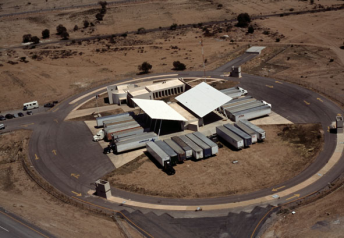
In addition, the city has the Interpuerto Parque Logístico; This customs area is the fourth most important in Mexico due to world-class services, infrastructure and strategic locations. Parque Logístico is the highest level industrial development and unique of its kind that has the best real estate services, intermodal terminal, own operation, logistics services, in addition to having the new program called Strategic Fiscalized Enclosure.
Parque Logistico is the result of a partnership between Hines and Grupo Valoran, a leading San Luis Potosí developer. This world-class industrial park includes Interpuerto, an on-site intermodal facility and customs operation which will be able to accommodate both manufacturing and warehousing/distribution operations in the Park’s well-planned layout. Intermodal facilities, like Interpuerto, are land-based container terminals that allow for the quick and efficient transfer between road and rail transportation networks.
This state-of-the-art industrial and logistics park is located on Eje 140 bordered by Mexico’s most important trade route, Highway 57 (the NAFTA Highway) on the east and the principle north-south railway connecting the U.S. with Mexico on the west.
Source: https://www.hines.com/properties/parque-logstico-san-luis-potos
5. Touristic sites
San Luis Potosí is full of landmarks and places to visit with cultural and historic relevance. San Luis Potosí entire Historic Centre is cataloged as World Cultural Heritage by UNESCO.
Founders Plaza
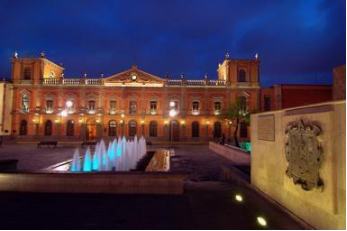
It was this place that was chosen in 1588 by Captain Miguel Caldera and the Franciscans to form the first settlement with the name "Puesto de San Luis," with groups of Guachichiles Indigenous. Here is where the first San Luis Church was erected, and it was known by the name of Ermita de la Santa Vera Cruz.
According to tradition, it was in the current Plaza de Fundadores, where there city of San Luis Potosi was officially founded on November 3, 1592, due to the discovery of gold and silver deposits in the San Pedro Hill. Today, we can see a memorial staircase with fountains representing the springs that supplied water to the earliest settlers of the city.
During Holy Week, this plaza becomes the crossroad for the Procession of Silence, and it is where the traditional event, The Burning of Judas, takes place.
From this square, you can see the beautiful: Loretto Chapel, Temple of the Company, and the Central Building of the Universidad Autonoma de San Luis Potosi (House of Studies).
Potosí Regional Museum
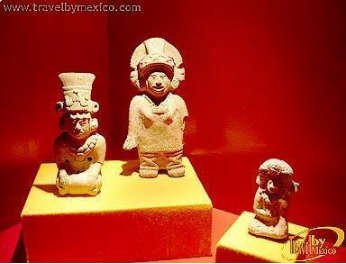
The Museo Regional Potosi is located within a Franciscan convent that was built in1586.The first floor contains the Aranzazu Chapel, a beautiful building done in Baroque style, a truly unique chapel in America.
This museum that opened on November 20,1952 displays an important collection of pre-Hispanic archaeological artifacts and paintings of the Viceroyalty.
Its four rooms offer a view of the geographical environment of the Huasteca Potosina, a description of the customs of the first settlers of the area, and information on the Tamtoc Archaeological Site that is located in the municipality of Tamuin. This cultural space also addresses the theme of Mesoamerican cultures, those that occupied a large part of Mexico and parts of Central America.
The museum is open to the public Tuesday to Sunday from 10:00 to 7:00. Admission is $37 pesos. The Potosi Regional Museum can be accessed from Independence Street, behind the San Francisco Church and under the arches of the Plaza de Aranzazu.
Federico Silva Museum of Contemporary Art
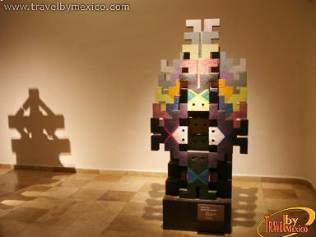
Located in the San Juan de Dios Garden, on what was formerly the old San Juan de Dios Convent Hospital, the Museo Federico Silva is the first Museum of Contemporary Sculpture in Latin America. Its wings spread over two floors, comprising works of Mexican master Federico Silva and several temporary exhibitions of contemporary art.
Originally from Mexico City, Federico Silva was born on September 16, 1923. He got his start in the arts by way of self-learning, and with the good fortune of being invited by David Alfaro Siqueiros to be his assistant. He was a member of the Academy of Arts of Mexico, in the section of Sculpture in 1991. He was named as a Emeritus Creator of the National Council for Culture and the Arts in 1993, and he received the National Prize of Arts and Sciences in 1995.
The Museum is open Monday to Saturday from 10:00 to 6:00, and on Sundays from 10:00 to 2:00. Closed on Tuesdays.
Festivals of Light in San Luis Potosi
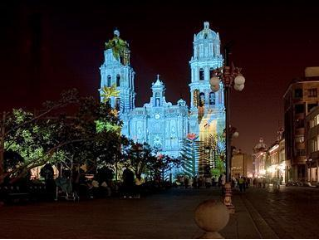
San Luis Potosi, as a member of LUCI (Lighting Urban Community International), and the World Association of Cities of Light, is the first city in Latin America to hold a Festival of Light. In Europe, a similar festival is held from December 5 to 8 in the City of Lyon, France.
As part of the celebrations for being the only Latin American city to be part of the global illumination program, San Luis Potosi hosted in December 2007, March and November 2008, two major Festivals of Light. The first was displayed at El Carmen Church, and the second at the Metropolitan Cathedral, in both cases bringing thousands of visitors attracted by the flashing colors of the dazzling spectacle.
The next edition of the Winter Light Festival 2008 called “A Wall of Light in San Luis Potosi” was held from December 13, 2008 to January 6, 2009 in the Founders Plaza (illuminating the Central Building of the University, The Loretto Chapel, and the Church of the Company), in the historical heart of the city.
The work of French painter and stage designer Xavier de Richemont, this show is done through countless sets of lasers, lights, prisms, photographs, images and world class technology, which include elements of history and San Luis culture, and illuminate the facades of these buildings.
Source: http://en.travelbymexico.com/sanluispotosi/places-to-visit/
6. History and Culture
Pre-colonial period
In pre-Hispanic times the territory now occupied by the state of San Luis Potosí included two cultural areas: Mesoamerica and Aridoamerica. While the southern and eastern regions of the state were occupied by Otomi and Huastec kingdoms, its northern and central-west regions, where the city of San Luis now is located, were inhabited by Chichimeca. Chichimeca is a generic term given to various nomadic ethnicities which inhabited the northern fringes of the Aztec Empire, which is now northern Mexico. As they were nomadic peoples, they did not build large cities nor have permanent settlements like most Mesoamerican civilizations. They are described by historians as very warlike peoples, living in continual wars among themselves. These tribes spoke different languages but their customs were similar.
After the arrival of Spanish conquistadores and their indigenous allies into the territory now formed by the Mexican nation, it still took them about a century to colonize the northern territories in Aridoamerica. When the settlers founded the first settlements in the region in late 16th century, they had to struggle against constant attacks from Guachichil tribes. Extremely belligerent, these tribes attacked traders who traveled to Zacatecas in newly created routes. Conquistadores and religious missionaries called the place where San Luis now is located "El Gran Tunal" (Grand Place of Tuna fruit). Finally, in 1589, peace between Chichimeca peoples and Spanish settlers was reached thanks to efforts made by Miguel Caldera and Brother Diego de la Magdalena, which marked the end of the Chichimeca War.
Colonial period
A Franciscan mission was established in the zone in 1583, nine years before the city's founding. In early 1592 the mines of Cerro de San Pedro were discovered. The lack of water in Cerro de San Pedro made impossible a new settlement in that specific area, as well as the proper exploitation of the minerals. A short distance away there was a valley where water was abundant. This originated the creation of a new township to facilitate the labors of mining extraction. The legal foundation of the town of San Luis Potosí was made in November 3, 1592, according to a charter commission raised by Viceroy Luís de Velasco and given to Miguel Caldera (considered the historic founder of the city) and Juan de Oñate.
Independence
For a time in 1863, during the French invasion of Mexico, San Luis Potosí served as the capital of the republican government, under President Benito Juárez.
The Plan of San Luis Potosí, issued November 20, 1910, was the opening shot of Mexico's revolution against the dictator Porfirio Díaz. The 1910 presidential election was stolen when Díaz had his opponent Francisco I. Madero arrested and imprisoned. Madero fled and issued the Plan of San Luis Potosí, declaring the election void and calling upon Mexicans to take up arms against the government.
Today, the downtown is one of plazas and colonial architecture. The "Plaza de Armas" is the site of a cathedral and governor's palace (1770). The nearby "Templo de Nuestra Señora del Carmen," with its colorful-tiled domes and famous altars, is considered among Mexico's finest churches. In addition, San Luis is home to the bullring Plaza de Toros Fermin Rivera.
Outside the center, a modern industrial city has begun to grow.
The Universidad Autónoma de San Luis Potosí (UASLP) is in the city. Based on a Jesuit College founded in 1624, the Instituto Científico y Literario was raised to the category of a university in 1923, and it is recognized as one of Latin America's best universities.
Today
With a population of approximately one million inhabitants, it is now the tenth-largest metropolitan area in Mexico. The city is a major commercial and industrial center. It lies in an economically advantageous area at the heart of the "triangle" formed by the three largest cities in Mexico: Mexico City, Guadalajara and Monterrey.
In recent years, the city has attracted the attention of European and American investors; its political, social, and economic stability has convinced large multinational companies to assume a presence there and to buy land, on the outskirts of the city.
Recently, according to a survey conducted by the magazine The Investor, San Luis Potosí and its metropolitan area was the third-best place to live in Mexico.
7. Other information of interest
Procession of Silence, this is an annual event commemorating the passion and death of Christ. It occurs on the night of Good Friday, starting at the Templo del Carmen, from where it originates and proceeding through the streets of the historic center of the city of San Luis Potosí. Drums and bugles are played as a part of the procession, but participants and spectators do not speak, meriting its name. It is one of the most important celebrations of Easter in Mexico and was declared part of the cultural heritage of the state of San Luis Potosí in 2013.
The procession takes place on Good Friday, in the historical center of the city of San Luis Potosi, which is filled with churches and colonial era buildings. Illuminated with candles, the area has a church-like atmosphere and even though thousands of spectators line the streets, no one will speak during the hours of the procession, which gives it the name.
The main participants of the procession are the members of various religious brotherhoods, who carry and accompany large platforms with religious images through the streets. In 2013, there were thirty such brotherhoods which included the Cofradía del Virgen del Carmen, the Cofradía del Santo Entierro, Cofradía del Descendimiento, Cofradía del Ecce Homo and the Cofradía de la Soledad, which carries an image of Our Lady of Solitude. The members of the various brotherhoods are identified by the colors of their garments, which identified their home parish and shows the influence of the processions of Seville. The most noticeable participants are the costaleros, which were a special tunic and pointed hoods with cloths covering the faces. The brotherhoods participate as a form of penance, with faces covered and some even walking with chains attached to their ankles. Other participants include adults and children in various dress which include altar boys, Nazarenes, Our Lady of Macarena, Roman soldiers, women wearing traditional Potosi rebozos and carrying candles, bullfighters, politicians and artists.
8. Contact Information
City Mayor: Xavier Nava Palacios
Contact number: +52 (444) 834 5400
Govt. Office Address: BLVD. SALVADOR NAVA MARTÍNEZ 1580, COL. SANTUARIO, C.P.: 78380, SAN LUIS POTOSÍ, S.L.P., MÉXICO
Facebook: https://www.facebook.com/XavierNavaSLP
Twitter: https://twitter.com/navaslp?lang=en
